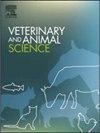饲粮中添加酒糟对饲粮富含n-3多不饱和脂肪蛋鸡氧化应激、蛋品质和蛋黄脂质稳定性的影响
IF 1.9
Q2 AGRICULTURE, DAIRY & ANIMAL SCIENCE
引用次数: 0
摘要
酒渣(WLs)是酿酒过程的副产品,但其作为家禽饲料的价值尚未实现。因此,本研究的目的是评估使用wl作为饲料原料的潜在效益。为此,我们研究了饲粮中添加n-3 PUFA对脂质过氧化易感蛋鸡血清和肝脏氧化应激指标及蛋品质的影响。此外,还对贮藏期间蛋黄的脂质特征和氧化稳定性进行了评价。选取30周龄利乐SL蛋鸡128只,随机分为4组(n = 32):阴性对照组(C -组)饲喂标准饲粮,阳性对照组(C +组)、WL2.5组和WL5组(WL5组)饲喂在标准饲粮中添加5%富含n-3 PUFA的亚麻籽油的饲粮。在WL2.5和WL5组,饲粮中分别添加2.5%和5%的wl。n-3 PUFA摄入增加可诱导氧化应激,其表现为丙二醛(MDA)升高,血清和肝脏抗氧化酶活性降低。然而,在添加WLs的母鸡中,这些参数显著提高。添加WLs的母鸡贮藏蛋中n-3 PUFA含量降低了19%,而添加C+的母鸡贮藏蛋中n-3 PUFA含量降低超过33%。综上所述,添加WLs可以提高蛋鸡的产蛋量和蛋品质(蛋黄颜色和胆固醇含量),提高母鸡的抗氧化能力和鸡蛋的氧化稳定性,并有可能延长鸡蛋的保质期。本文章由计算机程序翻译,如有差异,请以英文原文为准。

Effect of dietary wine lees on oxidative stress, egg quality and yolk lipid stability in laying hens fed with a diet rich in n-3 polyunsaturated fats
Wine lees (WLs) are a by-product of the winemaking process, but the valorization of WLs as poultry feed has not yet been achieved. Accordingly, the aim of the present study was to evaluate the potential benefits of using WLs as a feed ingredient. To this end, we investigated their effects on serum and hepatic markers of oxidative stress and egg quality in laying hens susceptible to lipid peroxidation by feeding them diets enriched in n-3 PUFA. In addition, lipid profile and oxidative stability of the yolk during storage were evaluated. A total of 128 30-week-old Tetra SL laying hens were divided into four groups (n = 32): the negative control (C–) received a standard diet, while the three other groups (positive control, C+; WL2.5; and WL5) received the standard diet supplemented with 5 % linseed oil rich in n-3 PUFA. In the WL2.5 and WL5 groups, WLs were introduced into the diet at levels of 2.5 % and 5 %, respectively. The increased intake of n-3 PUFA induced oxidative stress, which was evidenced by increased malondialdehyde (MDA) and reduced serum and liver antioxidant enzyme activity. However, these parameters were significantly improved in hens supplemented with WLs. The reduction in n-3 PUFA content in stored eggs was < 19 % in hens fed with WLs, while the reduction exceeded 33 % in the C+ group. In conclusion, WLs can improve egg production and egg quality (yolk color and cholesterol content), the antioxidant status of hens and the oxidative stability of eggs, with the possibility of extending their shelf life.
求助全文
通过发布文献求助,成功后即可免费获取论文全文。
去求助
来源期刊

Veterinary and Animal Science
Veterinary-Veterinary (all)
CiteScore
3.50
自引率
0.00%
发文量
43
审稿时长
47 days
 求助内容:
求助内容: 应助结果提醒方式:
应助结果提醒方式:


